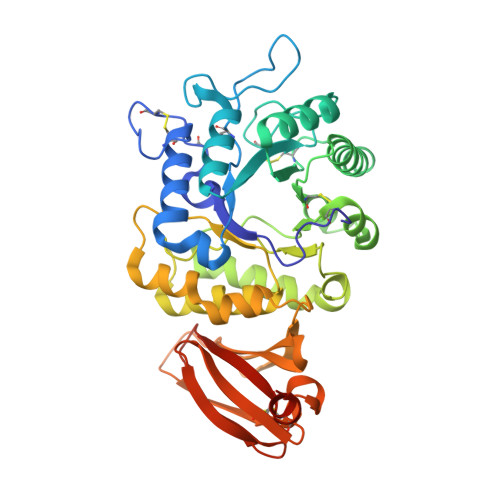Interconversion of the specificities of human lysosomal enzymes associated with Fabry and Schindler diseases.
Tomasic, I.B., Metcalf, M.C., Guce, A.I., Clark, N.E., Garman, S.C.(2010) J Biol Chem 285: 21560-21566
- PubMed: 20444686
- DOI: https://doi.org/10.1074/jbc.M110.118588
- Primary Citation of Related Structures:
3LX9, 3LXA, 3LXB, 3LXC - PubMed Abstract:
The human lysosomal enzymes alpha-galactosidase (alpha-GAL, EC 3.2.1.22) and alpha-N-acetylgalactosaminidase (alpha-NAGAL, EC 3.2.1.49) share 46% amino acid sequence identity and have similar folds. The active sites of the two enzymes share 11 of 13 amino acids, differing only where they interact with the 2-position of the substrates. Using a rational protein engineering approach, we interconverted the enzymatic specificity of alpha- GAL and alpha-NAGAL. The engineered alpha-GAL (which we call alpha-GAL(SA)) retains the antigenicity of alpha-GAL but has acquired the enzymatic specificity of alpha-NAGAL. Conversely, the engineered alpha-NAGAL (which we call alpha-NAGAL(EL)) retains the antigenicity of alpha-NAGAL but has acquired the enzymatic specificity of the alpha-GAL enzyme. Comparison of the crystal structures of the designed enzyme alpha-GAL(SA) to the wild-type enzymes shows that active sites of alpha-GAL(SA) and alpha-NAGAL superimpose well, indicating success of the rational design. The designed enzymes might be useful as non-immunogenic alternatives in enzyme replacement therapy for treatment of lysosomal storage disorders such as Fabry disease.
Organizational Affiliation:
Departments of Biochemistry & Molecular Biology, University of Massachusetts, Amherst, Massachusetts 01003, USA.


















